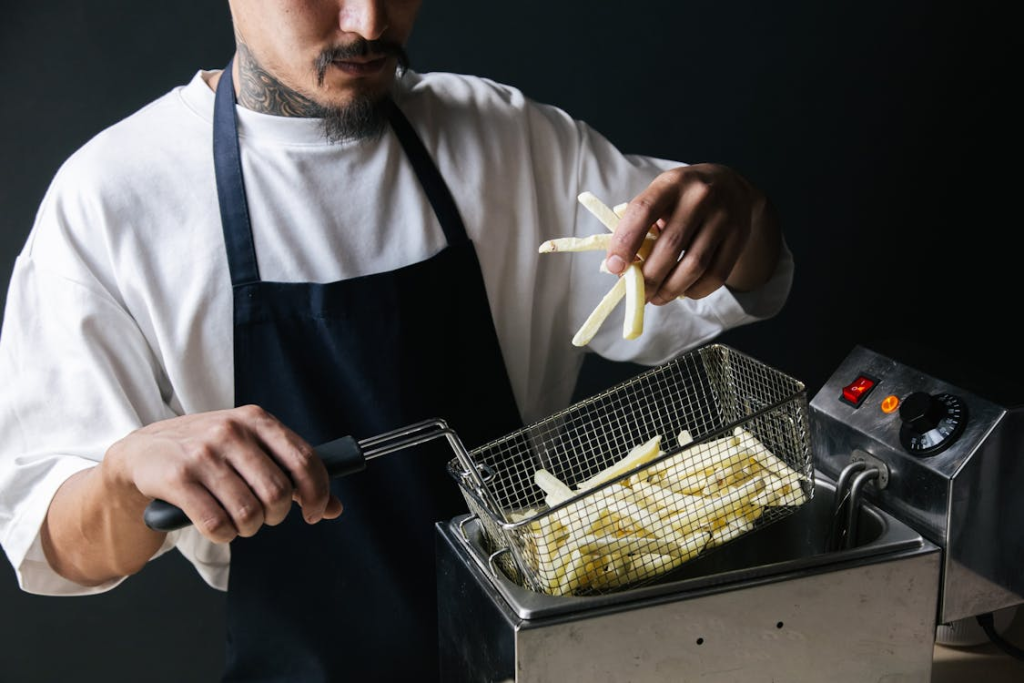Restaurant profitability hinges on controlling operational costs while maintaining quality standards. Among these costs, fryer operations represent a significant expenditure that often goes unoptimised.
Careful analysis using a savings in restaurant – calculator often reveals that fryer-related expenses make up a significant portion of food preparation costs in establishments serving fried items. Systematically optimising fryer operations is one of the most straightforward opportunities to enhance profitability without compromising food quality.
This comprehensive checklist outlines proven strategies for reducing fryer-related expenses, encompassing equipment selection, maintenance practices, oil management, and operational procedures. Implementing these recommended practices can dramatically reduce your operational expenses while maintaining or even improving product quality.
Equipment Selection and Configuration
The foundation of cost-effective fryer operations begins with selecting appropriate equipment. Even established restaurants benefit from reassessing their current setup against operational needs.
When evaluating fryer equipment, prioritize these considerations:
- Energy efficiency ratings (look for models with certification)
- Recovery time specifications (faster recovery typically reduces overall energy consumption)
- Oil capacity relative to production volume (avoid oversized fryers for your needs)
- Temperature control precision (±1°C control minimises oil degradation)
- Integrated filtration systems (reduce labour costs and improve consistency)
Replacing old fryers with modern energy-efficient models yields significant energy savings, helping businesses reduce costs while improving kitchen sustainability.
For establishments unable to replace equipment, retrofit options such as insulated covers, improved temperature controllers, and aftermarket filtration systems provide cost-effective alternatives with respectable return on investment (ROI) timeframes.
Maintenance Protocols
Having rigorous maintenance schedules significantly extends equipment lifespan while optimising operational efficiency. Proper maintenance prevents costly emergency repairs and maintains energy efficiency.
Daily maintenance tasks should include:
- thorough cleaning of fryer baskets and exterior surfaces
- inspection of heating elements for carbon buildup
- verification of thermostat accuracy using a calibrated thermometer
- assessment of oil quality using appropriate testing methods
Weekly maintenance should incorporate deeper cleaning of fryer wells, verification of safety systems, and inspection of electrical connections. Meanwhile, monthly comprehensive maintenance should include professional calibration of temperature controls, inspection of gas lines (where applicable), and evaluation of insulation integrity.

Oil Management Strategies
Cooking oil represents a significant expense in fryer operations, covering purchase, labour, and disposal costs. Across European countries, oil consumption averaged 22.1 million tonnes between 2020 and 2022, reflecting the high demand for edible oils in food service.
With such vast consumption levels, implementing systematic oil management practices is the single most effective strategy for controlling fryer-related expenses.
Effective oil management incorporates several interconnected practices:
- Implement scheduled filtration based on usage volumes rather than arbitrary timeframes.
- Train staff on proper skimming techniques during operational periods.
- Establish objective quality testing protocols using TPC meters or test strips.
- Implement oil rotation programmes that extend utility across multiple applications.
- Optimise frying temperatures for specific products rather than using standardised settings.
Operational Procedures
Daily operational procedures significantly impact fryer efficiency and oil longevity. Small adjustments to standard practices often yield substantial cost reductions without requiring capital investment.
Key operational considerations include:
- Temperature management: Reducing idle temperatures during slow periods and allowing proper warm-up times
- Loading practices: Maintaining appropriate food-to-oil ratios and avoiding overloading
- Cooking techniques: Properly draining products before frying and avoiding excessive basket shaking
- Staff training: Ensuring consistent implementation of best practices across all shifts
Energy Efficiency Optimisation
Beyond equipment selection, numerous operational strategies can significantly reduce energy consumption. These approaches often require minimal investment while delivering immediate returns.
Consider implementing these energy-saving practices:
- Install timer systems that automatically reduce temperatures during predictable slow periods
- Cover fryers during extended non-operational periods to retain heat
- Schedule production to minimise heating and cooling cycles
- Evaluate cooking temperatures to identify opportunities for slight reductions without quality impact
- Implement regular cleaning of heating elements to maintain optimal heat transfer
Waste Management and Recycling
Plenty of waste disposal companies partner with restaurants and other food service establishments. These companies specialise in recycling used cooking oil (UCO) into biodiesel or other renewable resources, reducing disposal fees while creating sustainable business practices.
The scale of UCO waste is significant. The UK alone produces approximately 250 million litres of used cooking oil (UCO) annually, averaging 4.2 litres per person. With an estimated 90% conversion efficiency, this volume could potentially yield up to 225 million litres of biodiesel each year if fully collected and processed.
Restaurants benefit from lower waste management costs, as conversion programmes eliminate the need for expensive disposal methods. Additionally, many recycling companies offer incentives or rebates for collected oil, providing an additional revenue stream.
Conclusion
Implementing this comprehensive fryer management approach delivers substantial cost reductions across multiple expense categories. While individual practices provide incremental benefits, the systematic implementation of this complete checklist can reduce total fryer-related expenses by 30-45%. These savings directly enhance bottom-line profitability without compromising food quality or customer satisfaction.
Treating fryer operations as a strategic opportunity rather than a fixed cost can help restaurant owners position themselves for enhanced competitiveness and sustainability in an increasingly challenging market.
Frequently Asked Questions
1. How do seasonal menu changes affect fryer cost optimisation?
Seasonal adjustments impact oil degradation, requiring filtration and temperature recalibration. Increase filtration frequency in winter when serving battered items, and lower fryer temperatures by 3–5°C in summer to extend oil life.
2. What role does water content play in fryer efficiency?
Water accelerates hydrolysis, breaking down oil faster. Reducing moisture before frying through draining, salting, or proper freezer-to-fryer practices can extend the lifespan of oil.
3. How do staffing patterns impact fryer cost control?
High staff turnover leads to increased oil consumption due to inconsistent techniques and reduced accountability. Standard operating procedures, shift-based tracking, and incentive programmes improve cost control.
4. What technological innovations are changing fryer cost management?
Real-time oil monitoring, IoT-enabled fryers, and automated filtration systems optimise usage and reduce costs. Retrofit solutions, such as advanced controllers, provide a return on investment (ROI) within 6–9 months while extending fryer longevity.

